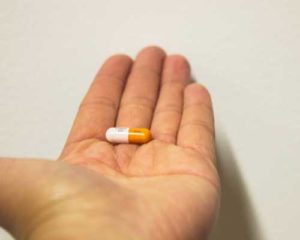Both methamphetamine and Adderall have significant potential for abuse. While they share many similarities, they are not the same drug.
Methamphetamine
Methamphetamine (brand name: Desoxyn) is a central nervous system stimulant drug that is usually a white, bitter-tasting powder. Desoxyn is available in pill form.
Crystal methamphetamine is a privately manufactured form of the drug that looks like bluish-white rocks or shards of glass.
The methamphetamine manufactured by professional laboratories is used to treat ADHD (attention deficit hyperactivity disorder) and narcolepsy, a sleep disorder.
Adderall
Adderall is the brand name of a prescription medication that contains both of the drugs amphetamine and dextroamphetamine: two central nervous system stimulants.
Like methamphetamine, the medication is designed to treat ADHD and narcolepsy.
Adderall comes in pill form. It can be used in an immediate-release or extended-release version.
Are They the Same?
When comparing the substances on a molecular or chemical level, methamphetamine and Adderall are very closely related. Differences between the two substances are quite minor.
Methamphetamine has an extra methyl group, a substance formed from three hydrogen atoms and one carbon atom. This extra methyl group makes the two substances chemically different but related.
It is believed that the extra methyl group in methamphetamine allows the drug to cross the blood-brain barrier quicker than other amphetamines. This makes methamphetamine a more potent drug than most other types of amphetamines.
Other Basic Similarities
Adderall and methamphetamine are considered to be central nervous system stimulant medications. They are both classified under the same controlled substance classification (Schedule II) by the United States Drug Enforcement Administration [DEA], and both require a prescription from a physician.

Adderall is far more likely to be prescribed for ADHD, narcolepsy, or other uses than methamphetamine. Most sources classify Adderall and methamphetamine as types of amphetamine drugs.
Additional Comparisons
Adderall is a prescription medication that may often be a drug of abuse. Some sources estimate that 30 percent of Adderall prescribed in the U.S. is diverted for illegal uses.
Adderall pills are taken orally, but they are typically ground up and snorted by abusers. The drug may be crushed and mixed with a solution to be injected.
Abuse of methamphetamine is primarily restricted to the private and illegal manufacture of crystal meth. This formulation is typically crushed and snorted, smoked, or mixed with a liquid and injected.
Effects of Both
As medications that stimulate the functioning of the central nervous system, both drugs share similar effects.
- Increased energy levels and even hyperactivity in some people
- Improved ability to focus
- Arousal of the sympathetic nervous system (increased body temperature, blood pressure, breathing rate, and heart rate)
- Decreased appetite and need for sleep
The effects of both drugs are dose-dependent, such that higher doses of the drug will produce hyperactivity instead of stimulation, difficulties paying attention as opposed to improving focus, the inability to sleep, and more drastic effects on the central and peripheral nervous systems.
Detrimental Effects
The detrimental effects of abusing either Adderall or methamphetamine are also very similar.
Certain types of effects may be more prevalent in individuals who use the drug in a specific manner. For instance, people who inject drugs are at an increased risk to develop blood-borne diseases and vascular issues, whereas people who smoke drugs are more likely to develop respiratory issues.

There are many other negative effects of methamphetamine and Adderall.
- Changes in the structure and functioning of the brain
- Cognitive issues associated with changes in the brain, including problems with attention, memory, and judgment
- Emotional issues associated with changes to the brain, including mood swings, significant depression, problems inhibiting emotions, and/or significant anxiety
- Altered motor functioning
- Severe dental problems or significant nasal problems (due to snorting)
- Hostile and aggressive behaviors
- Sores or infections of the skin
- Significant weight loss
- Psychosis, which most often includes hallucinations and/or delusions of a paranoid nature
- The development of a stimulant use disorder
Is Adderall Meth?
Is Adderall Meth?
Is Adderall meth? Well, Adderall falls under the class of drugs known as amphetamines, while the illicit drug meth is its chemical cousin. Both drugs are considered stimulants, and they both fall under the DEA’s Schedule II class of drugs. Adderall and meth are FDA-approved for attention-deficit hyperactivity disorder (ADHD), but there are some chemical differences between the two substances. However, meth is commonly illegally trafficked into the United States and abroad for illicit drug use. While Adderall is FDA-approved and also pure, the purity of methamphetamine can vary due to its production in clandestine labs in the United States or south of the border in Mexico.
Amphetamines vs. Methamphetamines
Amphetamines vs. Methamphetamines
While amphetamines like Adderall have chemical relations to meth, one difference between meth and Adderall is their slight chemical difference, causing meth to be far more potent than amphetamine. When it comes to releasing dopamine, also known as the body’s feel-good chemical, meth induces the release of much more, meaning individuals are more likely to abuse meth than Adderall. But does Adderall have meth in it? The answer is no. Methamphetamine also has more harmful side effects and is more likely to be abused.
How Close Is Adderall to Meth?
How Close Is Adderall to Meth?
One question you might have is how close is Adderall to meth? Well, on a chemical level, Adderall and meth are close to identical to the naked eye. Methamphetamine, however, has an added chemical component known as methyl, which is where it gets its name. Methyl consists of a single carbon atom, as well as three hydrogen atoms, separating it from Adderall.
Legal meth for ADHD does contain methamphetamine, as well as inert ingredients, such as sodium aminobenzoate and cornstarch. Street meth will contain more impurities than its prescription counterpart, including cutting agents used by dealers to stretch the profit of their product. Is Adderall like meth? Somewhat, but not really. Adderall is a mixture of various forms of amphetamines and related dextroamphetamines that include:
- Amphetamine Sulfate
- Dextroamphetamine Sulfate
- Amphetamine Aspartate Monohydrate
- Dextroamphetamine Saccharate
Adderall also contains food colorings and colloidal silicon dioxide, cornstarch, compressible sugar, microcrystalline cellulose, magnesium stearate, and saccharin sodium.
How Are Meth and Adderall Similar?
How Are Meth and Adderall Similar?
Although they possess many differences, Adderall and meth are similar in the following ways:
- Addiction risks: Since both are Schedule II substances, both drugs rank high for abuse potential, as well as addiction and dependence.
- Drug schedule: As Schedule II substances, both drugs possess legitimate medical uses.
- Medical use: Both drugs are approved by the FDA to treat ADHD
Side effects: Both drugs have similar side effects, which include the potential for cardiovascular issues, irritability, and excessive weight loss. When meth is abused, side effects include hostility, addiction, paranoia, and depression.
Can Adderall Or Methamphetamine Abuse Lead To Physical Dependence?
Yes. Both Adderall and methamphetamine have a significant potential to induce physical dependence in people who use the drugs regularly and in significant amounts. Physical dependence consists of the development of tolerance to the substance followed by later development of a withdrawal syndrome.
The withdrawal syndrome for stimulant drugs is similar across nearly every stimulant of abuse. The American Psychiatric Association lists the formal diagnostic symptoms for stimulant withdrawal as being applied to all stimulants of abuse.
Not Exactly The Same
Although methamphetamine and Adderall are very similar substances, they are not the same drug.
Many people view methamphetamine as a far more dangerous substance than Adderall. When they think of methamphetamine, they often think of crystal meth, whereas most people know that Adderall is a prescription medication. Both are potentially dangerous drugs of abuse.
Many sources, including the book Methamphetamine: Its History, Pharmacology, and Treatment, report the results of research studies where chronic abusers of methamphetamine were given Adderall, and they were not able to tell the difference between the effects of Adderall and the effects of methamphetamine. Thus, even though the drugs are slightly different chemically, their overall effects are very similar.
Crystal Meth
Methamphetamine refers to professionally manufactured medication. Crystal meth is the illicitly produced street version.
Although the chemical substances in methamphetamine and Adderall are similar, the process used to make crystal meth (the street version of methamphetamine) requires potentially dangerous and toxic substances, such as drain cleaner, ammonia, phosphorus, and other chemicals.
Abuse of crystal meth can lead to serious damage to organ systems in the body because of these potentially dangerous additives. Chronic abusers of crystal meth often suffer numerous neurological, physical, and emotional problems that may not be reversible.
Adderall and Meth Detox
Adderall and Meth Detox
Whether you’ve been using these drugs as prescribed by your doctor or abusing them, you’re going to experience a form of stimulant withdrawal. How long you’ve been using the drugs and the manner in which you use them will indicate the severity of your symptoms. Stimulant withdrawal results from your body relying on drugs to regulate cognitive focus and function. Over time, even someone who uses the drugs to study can develop physical dependence. If someone is addicted to Adderall or meth and tries to stop, they’ll battle withdrawal because their body is learning how to function without the chemicals.
Withdrawal symptoms can be both physically and psychologically taxing and can range from moderate to severe. The psychological withdrawal from stimulants is especially taxing, leading to relapse and the individual becoming suicidal or violent. For this reason, stimulant users must seek professional medical help when stopping these drugs.
Getting Help
A stimulant use disorder as a result of abusing Adderall or methamphetamine can be a life-threatening condition if it is not treated by professionals. Such abuse can result in severe physical and mental problems in the long run.
Treatment for abuse or methamphetamine abuse should consist of a well-rounded treatment program that is run by addiction treatment professionals. The vast majority of people who have developed substance use disorders are unable to change their behavior without professional help.

